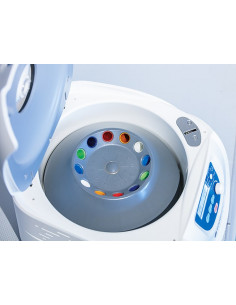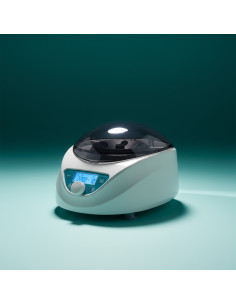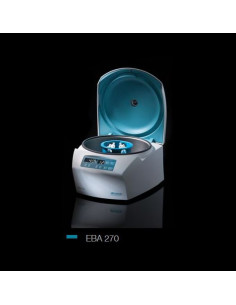Centrifuge
100401
Certified Class IIa Centrifuge – specifically designed for PRF and PRP therapies.
With a maximum speed of 4500 RPM and a relative centrifugal force (RCF) of up to 2490 x g, this centrifuge ensures precise and reliable separation of blood components. Its whisper-quiet operation at only 56 dB makes it perfect for use in quiet clinic and practice...
immediately available
€1,979.00
Centrifuge Hettich EBA 200
100347
The Hettich EBA 200 is a compact clinical centrifuge designed for small sample volumes. It features a built-in, versatile 8-place fixed-angle rotor and an adjustable LCD display for convenient and quick operation. The centrifuge is equipped with a standard 8-place fixed-angle rotor that can accommodate standard blood and urine tubes with a capacity of up...
immediately available
€1,399.00
PRP starter set | EBA 200 - Your solution for successful PRP production 🛍️🩸
100400
A PRP starter set containing all the components required for PRP production
1x Hettich EBA 200 centrifuge
2x PRP tubes | Vi PRP-Pro PU 10 pcs.
1x KIPIC® needle 25G x 42mm, PU 100 pcs.
1x KIPIC® Mesotherapy Needle 30G 4mm | PU 100 pcs.
1x KIPIC® Mesotherapy Needle 32Gx4mm | PU 100 pcs.
1x Mediware disposable syringes 5ml 3-piece Luer-Lock sterile (PU...
immediately available
€1,529.00
PRP Power Kit Pro - your complete set for professional PRP treatments
100399
The PRP Power Kit Pro contains all the essential components for successfully carrying out PRP therapies.
This PRP set consists of:
1x DUO centrifuge
2x PRP tubes | Vi PRP-Pro PU 10 pcs.
1x KIPIC® needle 25G x 42mm, PU 100 pcs.
1x KIPIC® Mesotherapy Needle 30G 4mm | PU 100 pcs.
1x KIPIC® Mesotherapy needle 32Gx4mm | PU 100 pcs.
1x Mediware disposable...
immediately available
€2,399.00
SERVOspin Evolve Centrifuge – 6×15 ml angle rotor – ideal for PRP preparation
100416
Compact, quiet laboratory and practice centrifuge for sample and plasma preparation; suitable for PRP according to tube/protocol specifications.
54° angle rotor for 6×15 ml
300–5000 rpm, up to 2600 g RCF
Digital control, RCF display, 2 program memories
Imbalance control, electronic lid lock, emergency opening
Quiet operation (~56 dB), 100–240 V
Ideal...
immediately available
€831.81
Centrifuge Hettich EBA 270
100359
The Hettich EBA 270 is a compact centrifuge with swing-out rotor, specially designed for medical practices. With a maximum speed of 4,000 rpm and an RCF of 2254, it is perfectly suited for centrifugation of conventional laboratory tubes with a capacity of 15 ml. The 90° rotating rotor enables precise separation of samples with separating gel. With its...
Last items in stock
€1,490.50









